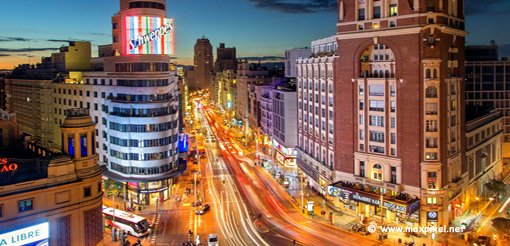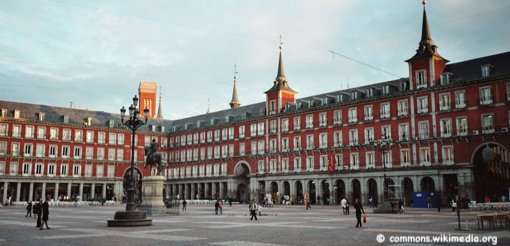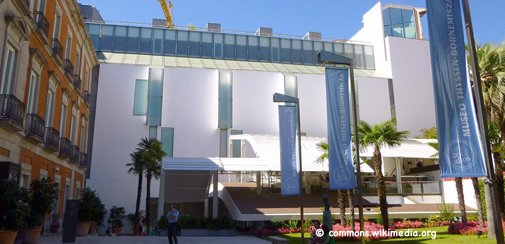Madrid
Madrid is the capital of Spain and the largest municipality in both the Community of Madrid and Spain as a whole. The city has almost 3.2 million inhabitants and a metropolitan area population of approximately 6.5 million.
It is the third-largest city in the European Union (EU), smaller than only London and Berlin and its monocentric metropolitan area is the third-largest in the EU, smaller only than those of London and Paris. The municipality covers 604.3 km2 (233.3 sq mi).
Madrid lies on the River Manzanares in the centre of both the country and the Community of Madrid (which comprises the city of Madrid, its conurbation and extended suburbs and villages).
You can buy our complete Madrid Offline City Guide on Apple Store or Google Play Store.
Most popular places to visit in Madrid are:
El Rastro
El Rastro also known as El Rastro de Madrid, is the most popular open air flea market in Madrid. It is held every Sunday and public holiday during the year and is located along Plaza de Cascorro and Ribera de Curtidores, between Calle Embajadores and the Ronda de Toledo.
A great variety of products (new and used) can be found at el Rastro. A number of antique shops in the local area are also open on
Sunday.
Address: Calle de la Ribera de Curtidores, 28005 Madrid
Reach:
Metro: 5 (La Latina)
Metro: 5 (Puerta de Toledo)
Bus: M1 (Embajadores - Centro Mayores)
Bus: 17, 18, 23, 35, 60, N26 (Toledo - Humilladero)
Opening Hours:
Sun and public holidays: 9:00 - 15:00
El Retiro Park
The Buen Retiro Park also known as Parque del Buen Retiro, literally Park of the Pleasant Retreat or simply El Retiro, is one of the largest parks of the city of Madrid, Spain.
The park belonged to the Spanish Monarchy until the late 19th century, when it became a public park. The Buen Retiro Park is a large and popular 1.4 km2 (350 acres) park at the edge of the city centre, very close to the Puerta de Alcalá and not far from the Prado Museum.
A magnificent park, filled with beautiful sculptures and monuments, galleries, a peaceful lake, and a host to a
variety of events, it is one of Madrid's premier attractions.
Address: Plaza de la Independencia, 7, 28001 Madrid
Reach:
Metro: 2 (Retiro)
Metro: 9 (Ibiza)
Bus: 2, 20, 28 (Alcalá - Retiro)
Bus: 1, 2, 9, 15, 19, 20, 51, 52, 74, 146, N2, N3, N5, N6, N7, N8 (Puerta De Alcalá)
Bus: 19 (Casón Del Buen Retiro)
Opening Hours:
Spring - Summer (April - September): Mon - Sun: 6:00 - 00:00
Autumn - Winter (October - March):Mon - Sun: 6:00 - 22:00
Gran Vía
Gran Vía (literally Great Way) is a street located in central Madrid, Spain. It leads from Calle de Alcalá, close to Plaza de Cibeles, to Plaza de España. The street, sometimes referred to as the Spanish Broadway, is one of the city's most important shopping areas, with a large number of hotels and large movie theatres; however, in recent years, many of these theatres have been replaced by shopping centres.
The Gran Vía serves as showcase of early 20th-century revival architecture, with architectural styles ranging from Vienna Secession style, Plateresque, Neo-Mudéjar, Art Deco, and others.
Address: Gran Vía, Madrid
Reach:
Metro: 1, 5 (Gran Vía)
Metro: 3, 5 (Callao)
Bus: 1, 2, 46, 74, 146, N16, N18, N19, N20, N21 (Gran Vía - Callao)
Monumental Bridge of Arganzuela
The monumental bridge of Arganzuela or Perrault Bridge is located in the Spanish city of Madrid. It crosses the Manzanares River and the Madrid River Park, linking the districts of Carabanchel and Arganzuela. It is located between the Bridge of Toledo and the Prague Bridge. It was designed by the French architect Dominique Perrault.
Its construction began at the end of 2010 and was inaugurated in March 2011. The bridge consists of two sections joined by an artificial hill located on the north side of the river. The south section is 150 meters long and crosses the Manzanares river perpendicularly, connecting the central hill with the equipment area, located between Avenida del Manzanares and Antonio López street.
The northern section, 128 meters long, unfolds over the Parque de la Arganzuela, linking the hill with the Paseo de Yeserías.
Address: Paseo de las Yeserías, 19, 28005 Madrid
Reach:
Metro: 5 (Pirámides)
Bus: 18, N12 (Yeserías)
Bus: 18, N12 (Parque De La Arganzuela)
Plaza Mayor
The Plaza Mayor also known as Plaza Mayor Square, was once the center of Old Madrid, but today is the heart of Madrid, Spain. It was first built (1580–1619) during the Habsburg period of Philip III 's reign. Only a few Spanish blocks away is another famous plaza, the Puerta del Sol.
The Plaza Mayor is for the people of Madrid and tourists to shop, walk around, eat, and enjoy the outdoors. There is a bronze statue of King Philip III at the center of the square, created in 1616 by Jean Boulogne and Pietro Tacca.
Giambologna's equestrian statue of Philip III dates to 1616, but it was not placed in the center of the square until 1848. The statue was a gift from the Duke of Florence at that time. It was Queen Isabel II ordered to move it from Casa de Campo to become the centerpiece of the Plaza Mayor.
Address: Plaza Mayor, 28012 Madrid
Reach:
Prado Museum
The Prado Museum also knawn as Museo del Prado, is the main Spanish national art museum, located in central Madrid. It is widely considered to have one of the world's finest collections of European art, dating from the 12th century to the early 20th century, based on the former Spanish Royal Collection, and the single best collection of Spanish art.
Founded as a museum of paintings and sculpture in 1819, it also contains important collections of other types of works. El Prado is one of the most visited sites in the world, and it is considered one of the greatest art museums in the world.
Address: Calle Ruiz de Alarcón 23, 28014 Madrid
Reach:
Metro: 1 (Estación del Arte)
Bus: 10, 14, 27, 34, 37, 45, N9, N10, N11, N12, N13, N14, N15, N17, N25 (Museo Del Prado)
Opening Hours:
Mon - Sat: 10:00 - 20:00
Sun and Holidays: 10:00 - 19:00
Entrance Fee:
Adults: 15 €
Children (under 18 years): Free
Website: www.museodelprado.es
Puerta de Alcalá
The Puerta de Alcalá also known as Alcalá Gate, is a Neo-classical monument in the Plaza de la Independencia in Madrid, Spain. It is regarded as the first modern post-Roman triumphal arch built in Europe, older than the similar monuments Arc de Triomphe in Paris and Brandenburg Gate in Berlin.
It was a gate of the former Walls of Philip IV. It stands near the city center and several meters away from the main entrance to the Parque del Buen Retiro. The square is bisected by Alcalá Street, although the street does not cross through the monument, and it is the origin of the Alfonso XII, Serrano and Olózaga streets. It's name originates from the old path from Madrid to the nearby town of Alcalá de Henares.
Address: Plaza de la Independencia, 1, 28001 Madrid
Reach:
Metro: 2 (Retiro)
Bus: 1, 2, 9, 15, 19, 20, 28, 51, 52, 74, 146, N2, N3, N5, N6, N7, N8 (Puerta De Alcalá)
Opening Hours: Open 24 hours.
Queen Sofia Museum
The Queen Sofía Museum also known as Museo Nacional Centro de Arte Reina Sofía, Museo Reina Sofía, El Reina Sofía or simply El Reina), is Spain's national museum of 20th-century art.
The museum was officially inaugurated on September 10, 1992, and is named for Queen Sofía. The museum is mainly dedicated to Spanish art. Highlights of the museum include excellent collections of Spain's two greatest 20th-century masters, Pablo Picasso and Salvador Dalí.
Address: Calle de Santa Isabel, 52, 28012 Madrid
Reach:
Metro: 1 (Estación del Arte)
Bus: 27, 34, C1, N12, N15, N17 (Reina Sofía)
Opening Hours:
Mon - Sat: 10:00 - 21:00
Sun: 10:00 - 19:00
Tue: Closed
Entrance Fee:
Adults: 10 €
Children and Youth (under 18 years): Free
Website: www.museoreinasofia.es
Royal Palace
The Royal Palace of Madrid is the official residence of the Spanish Royal Family at the city of Madrid, but it is only used for state ceremonies. The palace has 135,000 square metres (1,450,000 sq ft) of floor space and contains 3,418 rooms. It is the largest royal palace in Europe by floor area.
The palace is owned by the Spanish State and administered by the Patrimonio Nacional, a public agency of the Ministry of the Presidency. The palace is located on Calle de Bailén (Bailén Street) in the western part of downtown Madrid, east of the Manzanares River, and is accessible from the Ópera metro station.
Address: Calle de Bailén, s/n, 28071 Madrid
Reach:
Metro: 2, 5, R (Ópera)
Bus: 25, 39, 46, 75, 138, C2, N18, N19, N20 (Príncipe Pío)
Bus: 3, 148, N16 (Palacio Real)
Bus: 25, 33, 39, 41, 62, 138, C1 (Campo Del Moro)
Bus: 25, 33, 39, 41, 62, 138, C2 (Ermita Virgen Del Puerto)
Opening Hours:
Winter (October - March): 10:00 - 18:00
Summer (April - September): 10:00 - 20:00
Entrance Fee:
Basic Rate + Expo: 11 €
Thyssen-Bornemisza Museum
The Thyssen-Bornemisza Museum also known as the Museo Thyssen-Bornemisza (named after its founder), or simply the Thyssen, is an art museum in Madrid, Spain, located near the Prado Museum on one of city 's main boulevards. It is known as part of the 'Golden Triangle of Art', which also includes the Prado and the Reina Sofia national galleries.
With over 1,600 paintings, it was once the second largest private collection in the world after the British Royal Collection.
Address: Paseo del Prado, 8, 28014 Madrid
Reach:
Metro: 2 (Banco de España)
Bus: 10, 14, 27, 34, 37, 45, N9, N10, N11, N12, N13, N14, N15, N17, N25, N26 (Neptuno)
Opening Hours:
Mon: 12:00 - 16:00
Tue - Sun: 10:00 - 19:00
Entrance Fee:
Adults: 12 €
Students: 8 €
Website: www.museothyssen.org











